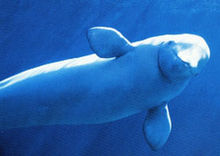- Monodontidae
-
Monodontidae
Temporal range: Late Miocene–Recent
Beluga whale Scientific classification 
Kingdom: Animalia Phylum: Chordata Class: Mammalia Order: Cetacea Superfamily: Delphinoidea Family: Monodontidae
Gray, 1821Genera see text
The cetacean family Monodontidae comprises two unusual whale species, the narwhal, in which the male has a long tusk, and the white beluga whale. They are native to coastal regions and pack ice around the Arctic Sea, and the far north of the Atlantic and Pacific Oceans.
Both species are medium-sized whales, between three and five metres in length, with a forehead melon, and a short or absent snout. They do not have a true dorsal fin, but do have a narrow ridge running along the back, which is much more pronounced in the narwhal. They are highly vocal animals, communicating with a wide range of sounds. Like other whales, they also use echolocation to navigate.[1]
Monodontids have a wide-ranging carnivorous diet, feeding on fish, molluscs, and small crustaceans. They have reduced teeth, with the beluga having numerous simple teeth, and the narwhal having only two teeth, one of which forms the tusks in males. Gestation lasts 14-15 months in both species, and almost always results in a single calf. The young are not weaned for a full two years, and do not reach sexual maturity until they are five to eight years of age. Family groups travel as part of herds, or 'pods', which may contain several hundred individuals.[1]
Taxonomy
The monodontids, dolphins (Delphinidae) and porpoises (Phocoenidae) together comprise the Delphinoidea superfamily. Genetic evidence suggests that the porpoises are more closely related to the white whales, and that these two families constitute a separate clade which diverged from the Delphinoidea within the past 11 mya.[2]
Suborder Odontoceti
- Superfamily Delphinoidea
References
- ^ a b Brodie, Paul (1984). Macdonald, D.. ed. The Encyclopedia of Mammals. New York: Facts on File. pp. 200–203. ISBN 0-87196-871-1.
- ^ Waddell, V.G. and Milinkovitch, M.C. and Bérubé, M. and Stanhope, M.J. (2000). "Molecular Phylogenetic Examination of the Delphinoidea Trichotomy: Congruent Evidence from Three Nuclear Loci Indicates That Porpoises (Phocoenidae) Share a More Recent Common Ancestry with White Whales (Monodontidae) Than They Do with True Dolphins (Delphinidae)". Molecular Phylogenetics and Evolution 15 (2): 314–318. doi:10.1006/mpev.1999.0751. PMID 10837160.
Categories:
Wikimedia Foundation. 2010.
